power steering fluid JEEP PATRIOT 2007 1.G Owners Manual
[x] Cancel search | Manufacturer: JEEP, Model Year: 2007, Model line: PATRIOT, Model: JEEP PATRIOT 2007 1.GPages: 440, PDF Size: 7.26 MB
Page 72 of 440
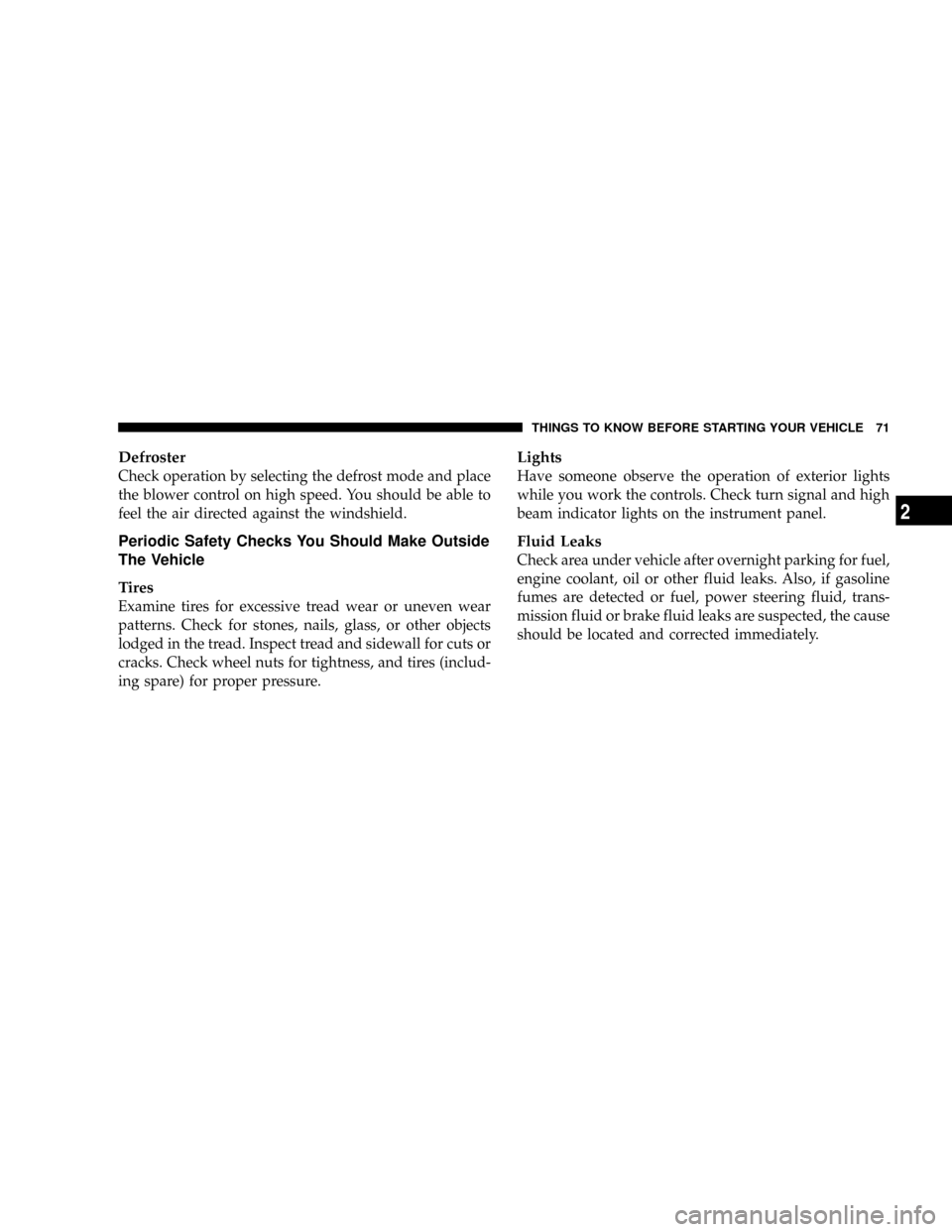
Defroster
Check operation by selecting the defrost mode and place
the blower control on high speed. You should be able to
feel the air directed against the windshield.
Periodic Safety Checks You Should Make Outside
The Vehicle
Tires
Examine tires for excessive tread wear or uneven wear
patterns. Check for stones, nails, glass, or other objects
lodged in the tread. Inspect tread and sidewall for cuts or
cracks. Check wheel nuts for tightness, and tires (includ-
ing spare) for proper pressure.
Lights
Have someone observe the operation of exterior lights
while you work the controls. Check turn signal and high
beam indicator lights on the instrument panel.
Fluid Leaks
Check area under vehicle after overnight parking for fuel,
engine coolant, oil or other fluid leaks. Also, if gasoline
fumes are detected or fuel, power steering fluid, trans-
mission fluid or brake fluid leaks are suspected, the cause
should be located and corrected immediately.
THINGS TO KNOW BEFORE STARTING YOUR VEHICLE 71
2
Page 277 of 440
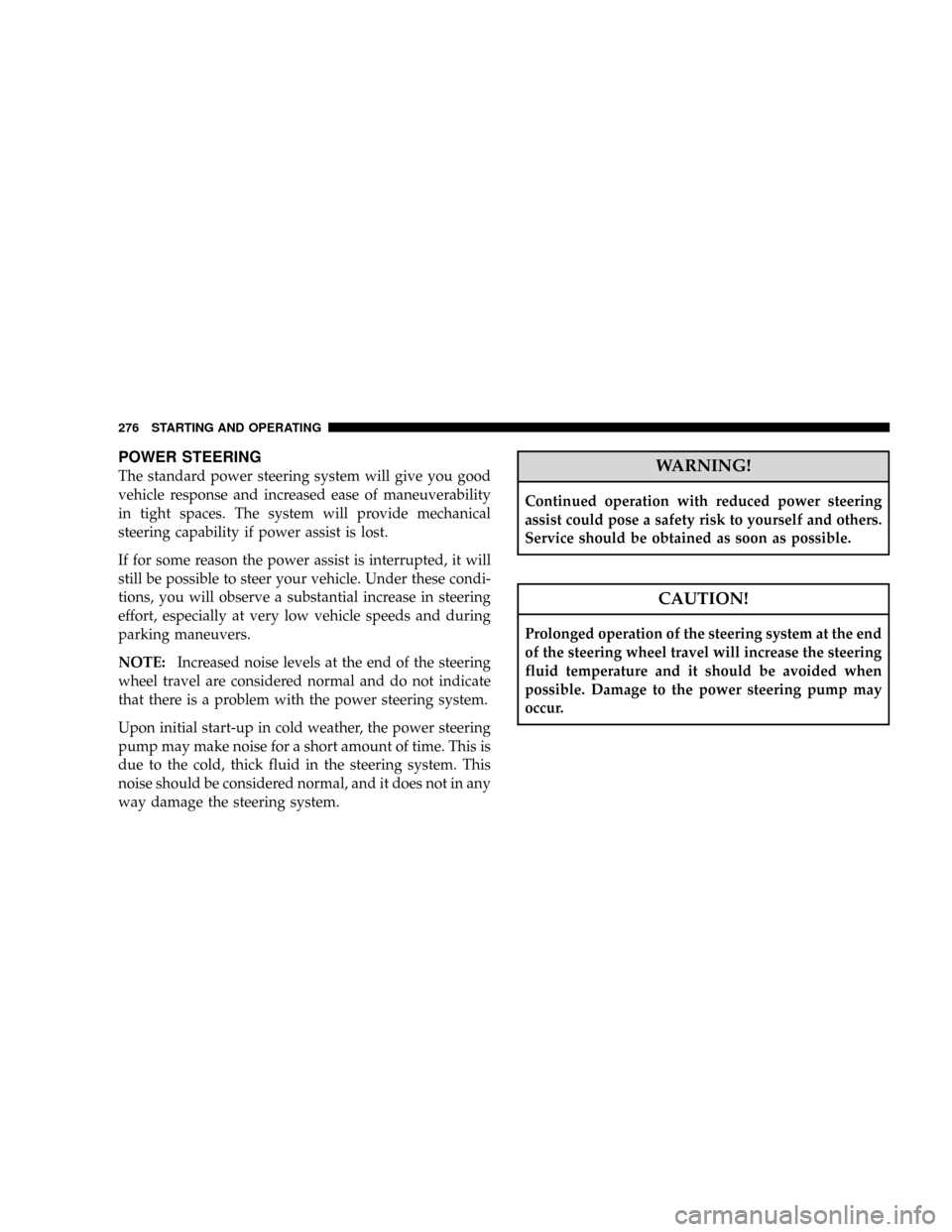
POWER STEERING
The standard power steering system will give you good
vehicle response and increased ease of maneuverability
in tight spaces. The system will provide mechanical
steering capability if power assist is lost.
If for some reason the power assist is interrupted, it will
still be possible to steer your vehicle. Under these condi-
tions, you will observe a substantial increase in steering
effort, especially at very low vehicle speeds and during
parking maneuvers.
NOTE:Increased noise levels at the end of the steering
wheel travel are considered normal and do not indicate
that there is a problem with the power steering system.
Upon initial start-up in cold weather, the power steering
pump may make noise for a short amount of time. This is
due to the cold, thick fluid in the steering system. This
noise should be considered normal, and it does not in any
way damage the steering system.WARNING!
Continued operation with reduced power steering
assist could pose a safety risk to yourself and others.
Service should be obtained as soon as possible.
CAUTION!
Prolonged operation of the steering system at the end
of the steering wheel travel will increase the steering
fluid temperature and it should be avoided when
possible. Damage to the power steering pump may
occur.
276 STARTING AND OPERATING
Page 340 of 440
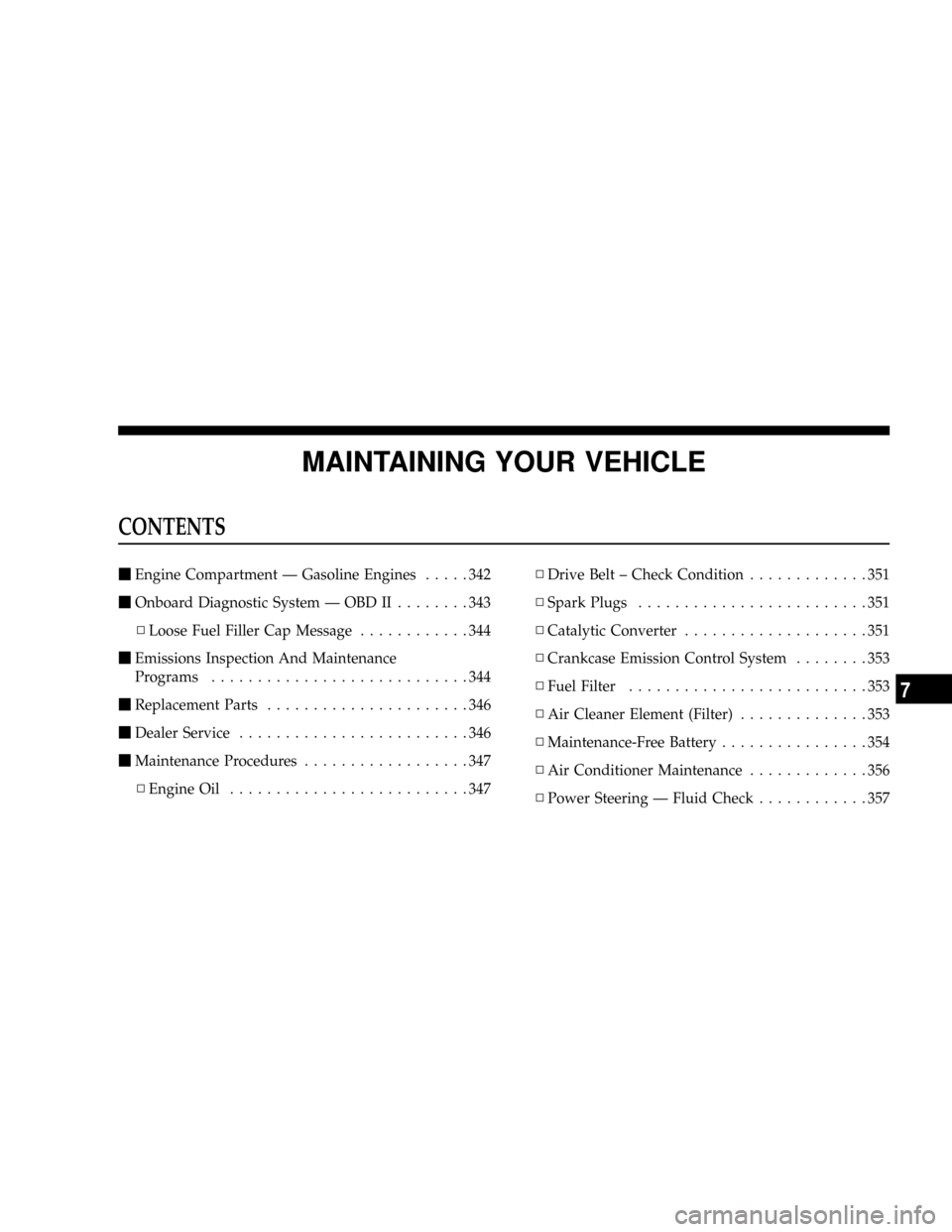
MAINTAINING YOUR VEHICLE
CONTENTS
mEngine Compartment Ð Gasoline Engines.....342
mOnboard Diagnostic System Ð OBD II........343
NLoose Fuel Filler Cap Message............344
mEmissions Inspection And Maintenance
Programs............................344
mReplacement Parts......................346
mDealer Service.........................346
mMaintenance Procedures..................347
NEngine Oil..........................347NDrive Belt ± Check Condition.............351
NSpark Plugs.........................351
NCatalytic Converter....................351
NCrankcase Emission Control System........353
NFuel Filter..........................353
NAir Cleaner Element (Filter)..............353
NMaintenance-Free Battery................354
NAir Conditioner Maintenance.............356
NPower Steering Ð Fluid Check............357
7
Page 358 of 440
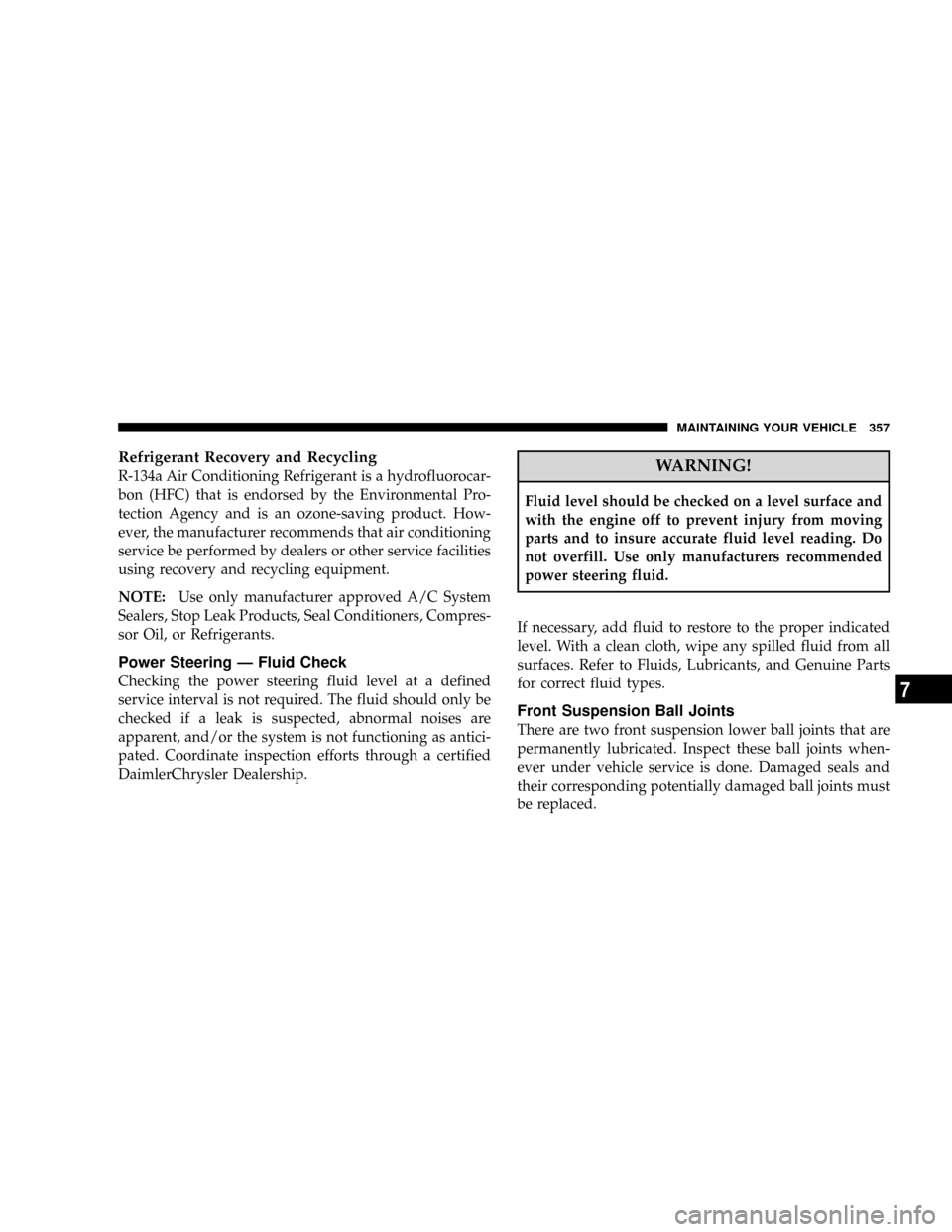
Refrigerant Recovery and Recycling
R-134a Air Conditioning Refrigerant is a hydrofluorocar-
bon (HFC) that is endorsed by the Environmental Pro-
tection Agency and is an ozone-saving product. How-
ever, the manufacturer recommends that air conditioning
service be performed by dealers or other service facilities
using recovery and recycling equipment.
NOTE:Use only manufacturer approved A/C System
Sealers, Stop Leak Products, Seal Conditioners, Compres-
sor Oil, or Refrigerants.
Power Steering Ð Fluid Check
Checking the power steering fluid level at a defined
service interval is not required. The fluid should only be
checked if a leak is suspected, abnormal noises are
apparent, and/or the system is not functioning as antici-
pated. Coordinate inspection efforts through a certified
DaimlerChrysler Dealership.
WARNING!
Fluid level should be checked on a level surface and
with the engine off to prevent injury from moving
parts and to insure accurate fluid level reading. Do
not overfill. Use only manufacturers recommended
power steering fluid.
If necessary, add fluid to restore to the proper indicated
level. With a clean cloth, wipe any spilled fluid from all
surfaces. Refer to Fluids, Lubricants, and Genuine Parts
for correct fluid types.
Front Suspension Ball Joints
There are two front suspension lower ball joints that are
permanently lubricated. Inspect these ball joints when-
ever under vehicle service is done. Damaged seals and
their corresponding potentially damaged ball joints must
be replaced.
MAINTAINING YOUR VEHICLE 357
7
Page 367 of 440
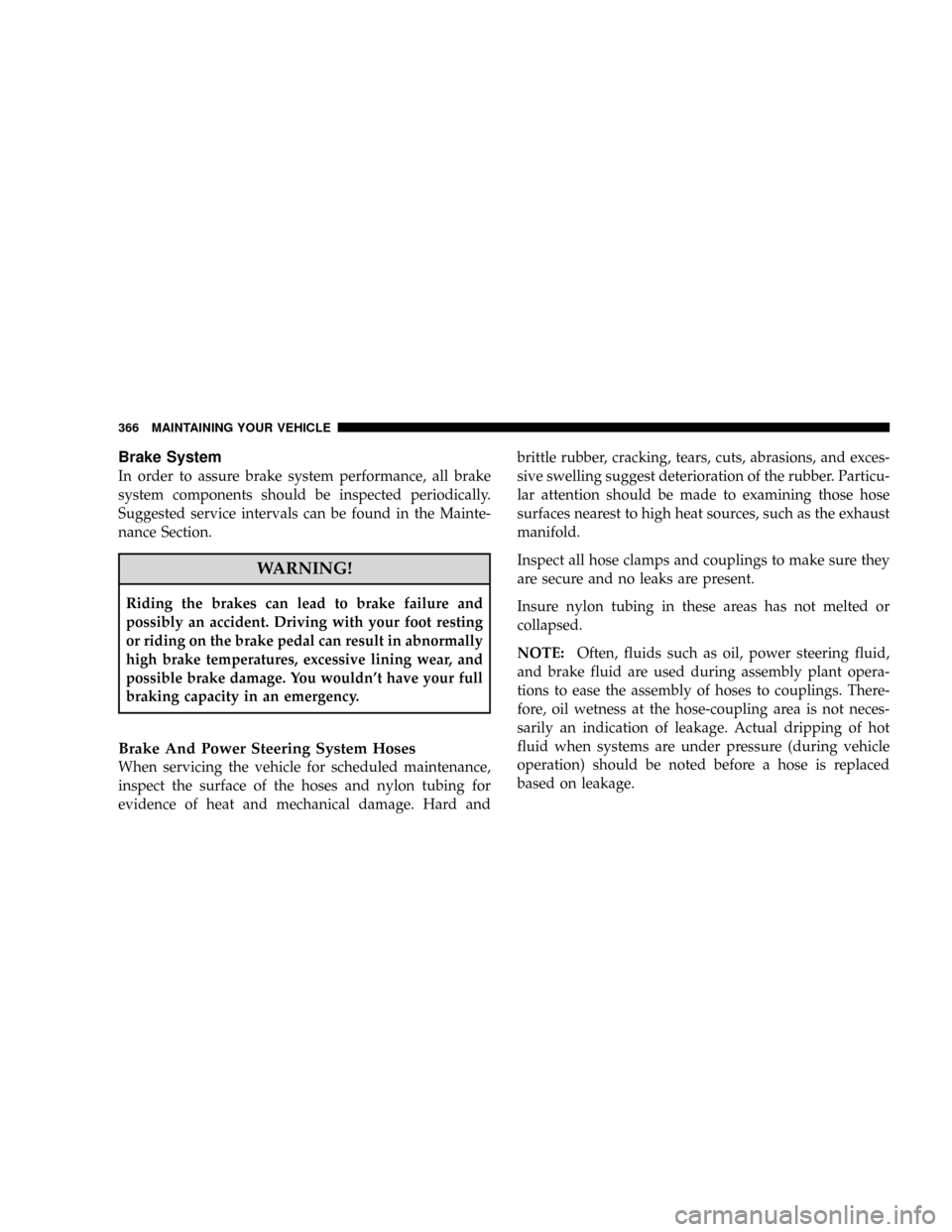
Brake System
In order to assure brake system performance, all brake
system components should be inspected periodically.
Suggested service intervals can be found in the Mainte-
nance Section.
WARNING!
Riding the brakes can lead to brake failure and
possibly an accident. Driving with your foot resting
or riding on the brake pedal can result in abnormally
high brake temperatures, excessive lining wear, and
possible brake damage. You wouldn't have your full
braking capacity in an emergency.
Brake And Power Steering System Hoses
When servicing the vehicle for scheduled maintenance,
inspect the surface of the hoses and nylon tubing for
evidence of heat and mechanical damage. Hard andbrittle rubber, cracking, tears, cuts, abrasions, and exces-
sive swelling suggest deterioration of the rubber. Particu-
lar attention should be made to examining those hose
surfaces nearest to high heat sources, such as the exhaust
manifold.
Inspect all hose clamps and couplings to make sure they
are secure and no leaks are present.
Insure nylon tubing in these areas has not melted or
collapsed.
NOTE:Often, fluids such as oil, power steering fluid,
and brake fluid are used during assembly plant opera-
tions to ease the assembly of hoses to couplings. There-
fore, oil wetness at the hose-coupling area is not neces-
sarily an indication of leakage. Actual dripping of hot
fluid when systems are under pressure (during vehicle
operation) should be noted before a hose is replaced
based on leakage.
366 MAINTAINING YOUR VEHICLE
Page 390 of 440
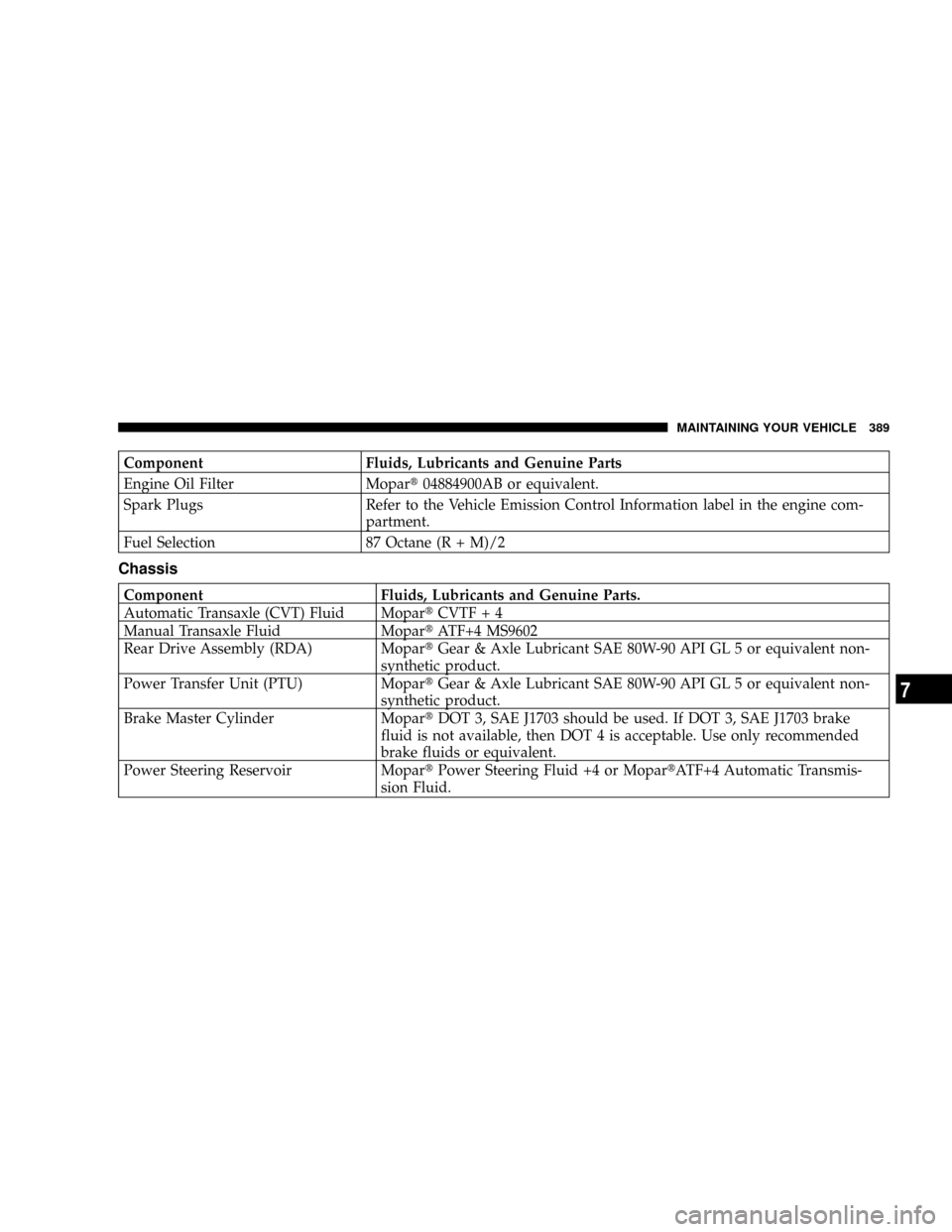
Component Fluids, Lubricants and Genuine Parts
Engine Oil Filter Mopart04884900AB or equivalent.
Spark Plugs Refer to the Vehicle Emission Control Information label in the engine com-
partment.
Fuel Selection 87 Octane (R + M)/2
Chassis
Component Fluids, Lubricants and Genuine Parts.
Automatic Transaxle (CVT) Fluid MopartCVTF + 4
Manual Transaxle Fluid MopartATF+4 MS9602
Rear Drive Assembly (RDA) MopartGear & Axle Lubricant SAE 80W-90 API GL 5 or equivalent non-
synthetic product.
Power Transfer Unit (PTU) MopartGear & Axle Lubricant SAE 80W-90 API GL 5 or equivalent non-
synthetic product.
Brake Master Cylinder MopartDOT 3, SAE J1703 should be used. If DOT 3, SAE J1703 brake
fluid is not available, then DOT 4 is acceptable. Use only recommended
brake fluids or equivalent.
Power Steering Reservoir MopartPower Steering Fluid +4 or MopartATF+4 Automatic Transmis-
sion Fluid.
MAINTAINING YOUR VEHICLE 389
7
Page 433 of 440
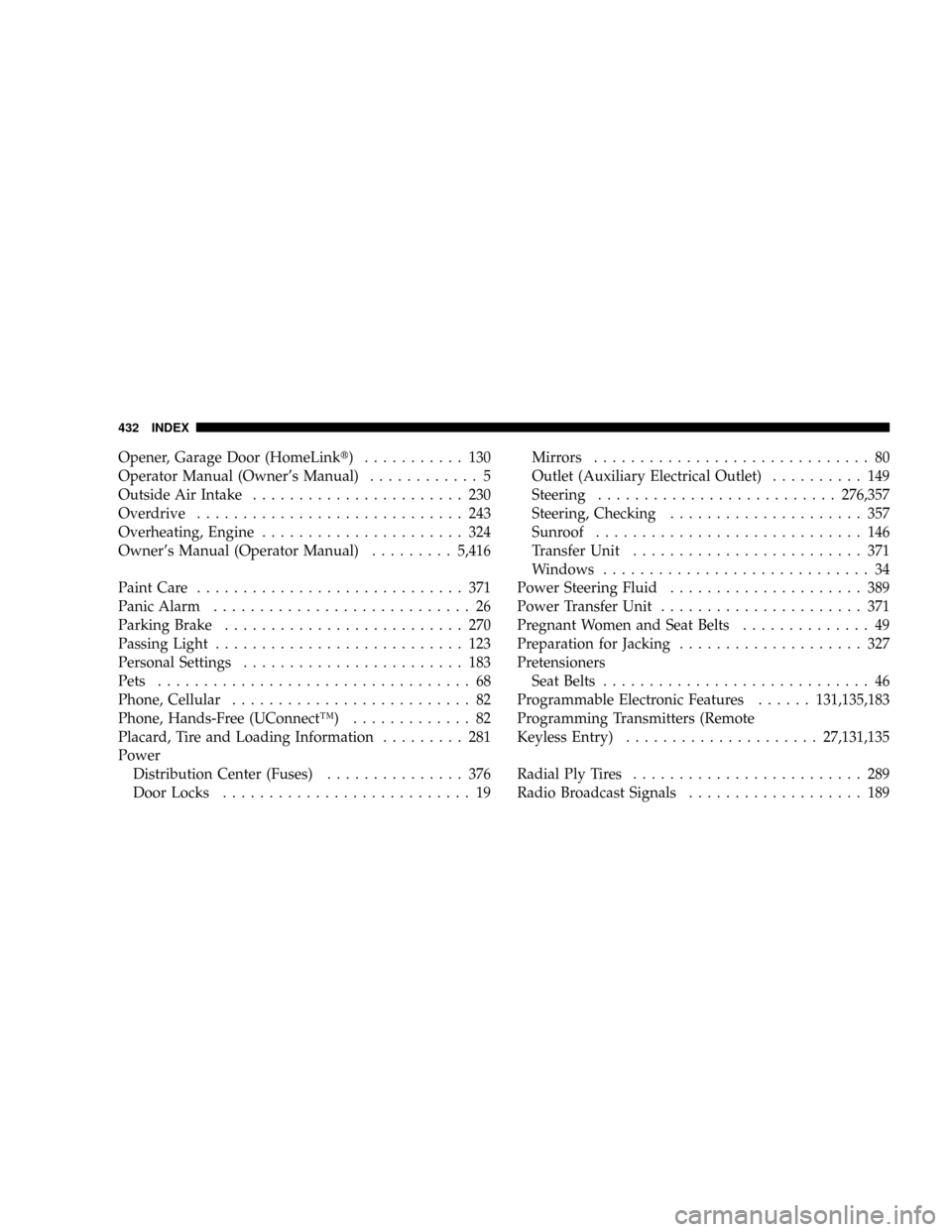
Opener, Garage Door (HomeLinkt) ........... 130
Operator Manual (Owner's Manual)............ 5
Outside Air Intake....................... 230
Overdrive............................. 243
Overheating, Engine...................... 324
Owner's Manual (Operator Manual).........5,416
Paint Care............................. 371
Panic Alarm............................ 26
Parking Brake.......................... 270
Passing Light........................... 123
Personal Settings........................ 183
Pets.................................. 68
Phone, Cellular.......................... 82
Phone, Hands-Free (UConnectŸ)............. 82
Placard, Tire and Loading Information......... 281
Power
Distribution Center (Fuses)............... 376
Door Locks........................... 19Mirrors.............................. 80
Outlet (Auxiliary Electrical Outlet).......... 149
Steering..........................276,357
Steering, Checking..................... 357
Sunroof............................. 146
Transfer Unit......................... 371
Windows............................. 34
Power Steering Fluid..................... 389
Power Transfer Unit...................... 371
Pregnant Women and Seat Belts.............. 49
Preparation for Jacking.................... 327
Pretensioners
Seat Belts............................. 46
Programmable Electronic Features......131,135,183
Programming Transmitters (Remote
Keyless Entry).....................27,131,135
Radial Ply Tires......................... 289
Radio Broadcast Signals................... 189
432 INDEX